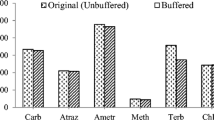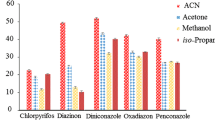Abstract
A simple method based on dispersive solid-phase extraction (DSPE) and dispersive liquid–liquid microextraction method based on solidification of floating organic droplets (DLLME-SFO) was developed for the extraction of chlorpyrifos (CP), chlorpyrifos-methyl (CPM), and their main degradation product 3,5,6-trichloro-2-pyridinol (TCP) in tomato and cucumber samples. The determination was carried out by high performance liquid chromatography with ultraviolet detection (HPLC-UV). In the DSPE-DLLME-SFO, the analytes were first extracted with acetone. The clean-up of the extract by DSPE was carried out by directly adding activated carbon sorbent into the extract solution, followed by shaking and filtration. Under the optimum conditions, the proposed method was sensitive and showed a good linearity within a range of 2–500 ng/g, with the correlation coefficients (r) varying from 0.9991 to 0.9996. The enrichment factors ranged from 127 to 138. The limit of detections (LODs) were in the range of 0.12–0.68 ng/g, and the relative standard deviations (RSDs) for 50 ng/g of each analytes in tomato samples were in the range of 3.25–6.26 % (n = 5). The proposed method was successfully applied for the extraction and determination of the mentioned analytes residues in tomato and cucumber samples, and satisfactory results were obtained.







Similar content being viewed by others
References
Anastassiades M, Lehotay SJ, Stajnbaher D, Schenck FJ (2003) Fast and easy multiresidue method employing acetonitrile extraction/partitioning and “dispersive solid-phase extraction” for the determination of pesticide residues in produce. J AOAC Int 86:412–431
Baskaran S, Kookana RS, Naidu R (2003) Contrasting behaviour of chlorpyrifos and its primary metabolite, TCP (3,5,6-trichloro-2-pyridinol), with depth in soil profiles. Aust J Soil Res 41:749–760
Bidari A, Ganjali MR, Norouzi P, Hosseini MRM, Assadi Y (2011) Sample preparation method for the analysis of some organophosphorus pesticides residues in tomato by ultrasound-assisted solvent extraction followed by dispersive liquid–liquid microextraction. Food Chem 126:1840–1844
Dagnac T, Garcia-Chao M, Pulleiro P, Garcia-Jares C, Llompart M (2009) Dispersive solid-phase extraction followed by liquid chromatography–tandem mass spectrometry for the multi-residue analysis of pesticides in raw bovine milk. J Chromatogr A 1216:3702–3709
Deme P, Azmeera T, Devi BLAP, Jonnalagadda PR, Prasad RBN, Sarathi UVRV (2014) An improved dispersive solid-phase extraction clean-up method for the gas chromatography–negative chemical ionisation tandem mass spectrometric determination of multiclass pesticide residues in edible oils. Food Chem 142:144–151
Díaz-Cruz MS, Barceló D (2006) Highly selective sample preparation and gas chromatographic–mass spectrometric analysis of chlorpyrifos, diazinon and their major metabolites in sludge and sludge-fertilized agricultural soils. J Chromatogr A 1132:21–27
Díez C, Traag WA, Zommer P, Marinero P, Atienza J (2006) Comparison of an acetonitrile extraction/partitioning and “dispersive solid-phase extraction” method with classical multi-residue methods for the extraction of herbicide residues in barley samples. J Chromatogr A 1131:11–23
Feng Y, Racke KD, Bollag JM (1997) Isolation and characterization of a chlorinated pyridinol degrading bacterium. Appl Environ Microbiol 63:4096–4098
Fontana AR, Camargo A, Martinez LD, Altamirano JC (2011) Dispersive solid-phase extraction as a simplified clean-up technique for biological sample extracts. Determination of polybrominated diphenyl ethers by gas chromatography–tandem mass spectrometry. J Chromatogr A 1218:2490–2496
García de Llasera MP, Reyes-Reyes ML (2009) A validated matrix solid-phase dispersion method for the extraction of organophosphorus pesticides from bovine samples. Food Chem 114:1510–1516
Kmellár B, Fodor P, Pareja L, Ferrer C, Martínez-Uroz MA, Valverde A, Fernandez-Alba AR (2008) Validation and uncertainty study of a comprehensive list of 160 pesticide residues in multi-class vegetables by liquid chromatography–tandem mass spectrometry. J Chromatogr A 1215:37–50
Leong MI, Huang SD (2008) Dispersive liquid–liquid microextraction method based on solidification of floating organic drop combined with gas chromatography with electron-capture or mass spectrometry detection. J Chromatogr A 1211:8–12
Martín J, Santos JL, Aparicio I, Alonso E (2015) Determination of hormones, a plasticizer, preservatives, perfluoroalkylated compounds, and a flame retardant in water samples by ultrasound-assisted dispersive liquid–liquid microextraction based on the solidification of a floating organic drop. Talanta 143:335–343
Nguyen TD, Yu JE, Lee DM, Lee GH (2008) A multiresidue method for the determination of 107 pesticides in cabbage and radish using QuEChERS sample preparation method and gas chromatography mass spectrometry. Food Chem 110:207–213
Peng GL, He Q, Al-Hamadani SMZF, Zhou GM, Liu MZ, Zhu H, Chen JH (2015) Dispersive liquid–liquid microextraction method based on solidification of floating organic droplet for the determination of thiamphenicol and florfenicol in environmental water samples. Ecotox Environ Safe 115:229–233
Randhawa MA, Anjum FM, Ahmed A, Randhawa MS (2007) Field incurred chlorpyrifos and 3,5,6-trichloro-2-pyridinol residues in fresh and processed vegetables. Food Chem 103:1016–1023
Vera-Avila LE, Rojo-Portillo T, Covarrubias-Herrera R, Peña-Alvarez A (2013) Capabilities and limitations of dispersive liquid–liquid microextraction with solidification of floating organic drop for the extraction of organic pollutants from water samples. Anal Chim Acta 805:60–69
Wu QH, Wang C, Liu ZM, Wu CX, Zeng X, Wen JL, Wang Z (2009) Dispersive solid-phase extraction followed by dispersive liquid–liquid microextraction for the determination of some sulfonylurea herbicides in soil by high-performance liquid chromatography. J Chromatogr A 1216:5504–5510
Wu XL, Hong HJ, Liu XT, Guan WB, Meng LX, Ye Y, Ma YQ (2013) Graphene-dispersive solid-phase extraction of phthalate acid esters from environmental water. Sci Total Environ 444:224–230
Xiong JF, Tang XY, Zhou GM, Guan Z, Wu LM (2013) Dispersive solid phase extraction coupled with HPLC-UV for simultaneous determination of chlorpyrifos and 3,5,6-trichloro-2-pyridinol in soil samples. Anal Methods 5:536–540
Yamini Y, Rezaee M, Khanchi A, Faraji M, Saleh A (2010) Dispersive liquid–liquid microextraction based on the solidification of floating organic drop followed by inductively coupled plasma-optical emission spectrometry as a fast technique for the simultaneous determination of heavy metals. J Chromatogr A 1217:2358–2364
Yang L, Zhao YH, Zhang BX, Yang CH, Zhang X (2005) Isolation and characterization of a chlorpyrifos and 3,5,6-trichloro-2-pyridinol degrading bacterium. FEMS Microbiol Lett 251:67–73
Zhang Y, Lee HK (2013) Low-density solvent-based vortex-assisted surfactant-enhanced-emulsification liquid–liquid microextraction combined with gas chromatography–mass spectrometry for the fast determination of phthalate esters in bottled water. J Chromatogr A 1274:28–35
Zhang X, Shen Y, Yu XY, Liu XJ (2012) Dissipation of chlorpyrifos and residue analysis in rice, soil and water under paddy field conditions. Ecotoxicol Environ Saf 78:276–280
Acknowledgments
This study was supported by the National Water Pollution Control and Management Technology Major Projects (No. 2012ZX07307-001).
Author information
Authors and Affiliations
Corresponding author
Additional information
Responsible editor: Roland Kallenborn
Rights and permissions
About this article
Cite this article
Peng, G., He, Q., Lu, Y. et al. Determination of organophosphorus pesticides and their major degradation product residues in food samples by HPLC-UV. Environ Sci Pollut Res 23, 19409–19416 (2016). https://doi.org/10.1007/s11356-016-7071-9
Received:
Accepted:
Published:
Issue Date:
DOI: https://doi.org/10.1007/s11356-016-7071-9




